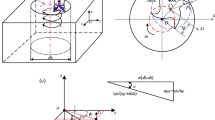Abstract
This paper is aimed to restrain the defects such as fluff and ablation, which were often found in machining of the aramid fiber-reinforced composites (AFRP). The cooling method of spray liquid nitrogen was adopted in the orthogonal milling process. The processing parameters including cutting depth, cutting speed, cooling temperature, feed speed, and liquid nitrogen flow were considered in details, and their effects on the processing quality were researched and analyzed. The analysis optimization methods of processing parameter were employed for the influence on the machining surface quality. Meanwhile, the optimal machining surface quality was predicted and verified. The results show that the cryogenic way realizes a bigger improved role on machining quality than the conventional one for AFRP. As well as the influence order of processing parameters on the roughness is cutting depth, cutting speed, cooling temperature, feed speed, and liquid nitrogen flow. And the predicted result Ra = 0.557 μm of minimum surface roughness value is similar with the actual one Ra = 0.572 μm and verifies the feasibility of optimization method. For processing of AFRP, the cooling way of spray liquid nitrogen has a positive role with high quality and efficiency.
Similar content being viewed by others
References
Meza F, Chen L, Hudson N (2013) Investigation of respiratory and dermal symptoms associated with metal working fluids at an aircraft engine manufacturing facility. Am J Ind Med 56(12):1394–1401
Kececi E, Asmatulu R (2014) Effects of moisture ingression on polymeric laminate composites and its prevention via highly robust barrier films. Int J Adv Manuf Technol 73(9–12):1657–1664
Azmi AI, Lin RJT, Bhattacharyya D (2013) Machinability study of glass fibre-reinforced polymer composites during end milling. Int J Adv Manuf Technol 64(1–4):247–261
Menail Y, El Mahi A, Assarar M (2016) Acoustic emission monitoring of damage mechanisms an aramid-epoxy composite after tensile fatigue and aging seawater. Mechanika 1:14–18
Cheng Z, Li BY, Huang JY (2016) Covalent modification of aramid fibers’ surface via direct fluorination to enhance composite interfacial properties. Mater Des 106:216–225
El-Taweel TA, Abdel-Maaboud AM, Azzam BS (2009) Parametric studies on the CO2 laser cutting of Kevlar-49 composite. Int J Adv Manuf Technol 40(9–10):907–917
Shuaib AN, AI-Sulaiman FA, Hamid F (2004) Machinability of Kevlar-49 composite laminates while using standard TiN coated HSS drills. Mach Sci Technol 8(3):449–467
Al-Sulaiman FA, Yilbas BS, Ahsan M et al (2009) CO2 laser cutting of Kevlar laminate: influence of assisting gas pressure. Int J Adv Manuf Technol 45(1–2):62–70
Jeremy G, Aaran J, Mohammad M, James S (2005) Low velocity impact of combination Kevlar/carbon fiber sandwich composites. Composite 4:396–406
Shi W, Liu HL, Zhang JB (2013) Research on cutting defects of aramid fiber composites. China Plastic 27(4):71–74
Zhuang Y (2013) Study on the combined machining technology of sawing and grinding for aramid composites. Master degree thesis of Dalian University of Technology, p 39–48
Zhang B, Sun B, Dang JK (2011) Study of stock removing process about aramid paper honeycomb composite. Hi-Tech Fiber & Application 36(6):22–25
Kim J, Mai Y (1991) Effects of interfacial coating and temperature on the fracture behaviours of unidirectional Kevlar and carbon fibre reinforced epoxy resin composites. J Mater Sci 26(17):4702–4720
Grubb DT, Li Z (1994) Single-fibre polymer composites. J Mater Sci 29(1):203–212
Bunsell AR (1975) Tensile and fatigue behaviour of Kevlar-49 (PRD-49) fibre. J Mater Sci 10(8):1300–1308
Wan YZ, Chen GC, Huang Y (2005) Characterization of three-dimensional braided carbon/Kevlar hybrid composites for orthopedic usage. Mater Sci Eng A398(1–2):227–232
Santhanakrishnan G, Krishnamurthy R, Malhotra SK (1988) Machinability characteristics of fibre reinforced plastics composites. J Mech Work Technol 17:195–204
Shokrani A, Dhokia V, Newman ST (2016) Investigation of the effects of cryogenic machining on surface integrity in CNC end milling of Ti–6Al–4V titanium alloy. J Manuf Process 21:172–179
Schoop J, Ambrosy F, Zanger F (2016) Cryogenic machining of porous tungsten for enhanced surface integrity. J Mater Process Technol 229:614–621
Pusavec F, Lu T, Courbonr C (2016) Analysis of the influence of nitrogen phase and surface heat transfer coefficient on cryogenic machining performance. J Mater Process Technol 233:19–28
Wang FB, Wang YQ, Hou B, Zhang JB, Li YP (2015) Effect of cryogenic conditions on the milling performance of aramid fiber. Int J Adv Manuf Technol 83(1):429–439
Ventura G, Martelli V (2009) Thermal conductivity of Kevlar 49 between 7 and 290 K. Cryogenics 49:735–737
Hartwig G, Knaak S (1984) Fibre-epoxy composites at low temperatures. Cryogenics 11:639–647
Zhang L (2001) Solid mechanics for engineers. Macmillan Press, Basingstoke, pp 102–156
Chen K (1996) Design and analysis of experiments. Tsinghua University press, Beijing, pp 94–184
Mei CL (2006) Practical statistical methods. Science press, Beijing, pp 218–242
Sohei S, Keiji Okamoto KK (1988) The effect of water-absorption and cryogenic temperature on the strength of ArFRP. Mater Sci Res Int 4(4):287–293
Author information
Authors and Affiliations
Corresponding author
Rights and permissions
About this article
Cite this article
Wang, F., Liu, J. & Shu, Q. Optimization of cryogenic milling parameters for AFRP. Int J Adv Manuf Technol 91, 3243–3252 (2017). https://doi.org/10.1007/s00170-017-0003-0
Received:
Accepted:
Published:
Issue Date:
DOI: https://doi.org/10.1007/s00170-017-0003-0




